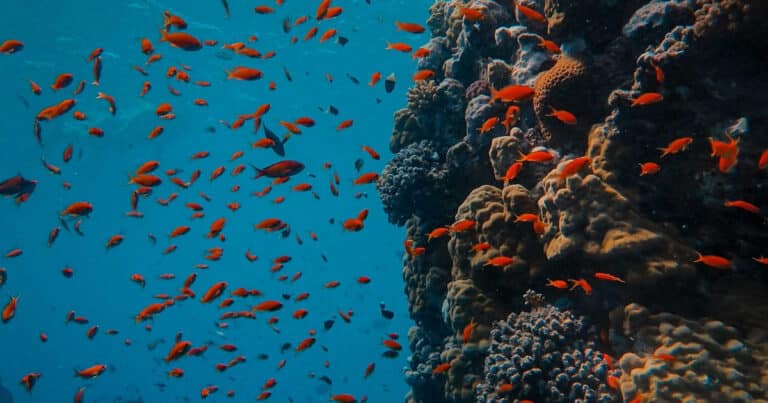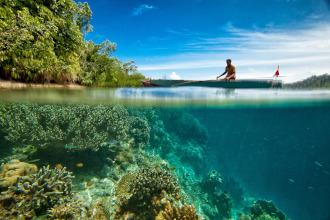By Sydney Cohen
Coral reefs are a vital part of the ocean ecosystem. Coral reefs help to keep our planet’s carbon dioxide levels under control by absorbing CO2 from the atmosphere. But these fragile ecosystems are in danger due to human activity.
What are Coral Reefs?
Coral reefs are large underwater structures composed of skeletons of marine invertebrates. Coral reefs are home to fish, crustaceans, mollusks, and other invertebrate species.
The actual structure of coral is created by organisms known as coral polyps. Coral polyps can take on many different forms, which is why there are so many varieties of coral structures! Thousands of species of corals have been found in all sea environments.
The majority of corals feed at night, through a polyp’s single stomach that opens at one end. Corals use nematocysts, or stinging cells, to capture their prey. Their prey consists of a range of species, such as microscopic zooplankton, and small fish, depending on the size of the polyp. They also gather small organic particles through their mucus films and strands.
Reef-building corals that live in shallow water have a symbiotic relationship with zooxanthellae, photosynthetic algae, that lives in their tissues. The coral supplies a home for these algae, with the compounds needed for their photosynthesis, while the zooxanthellae produce oxygen and carbohydrates that the coral polyps need in order to thrive, in addition to helping the coral remove waste.
The Important Biodiversity of Coral Reefs
Coral reefs are ecosystems with exceptional diversity. In fact, they “support more species per unit area than any other marine environment”. Scientists believe there may be millions of other species and resources that inhabit coral reefs that we have yet to discover.
The immense biodiversity within coral reefs aids in pharmaceutical developments, and many drugs are being made from the plants and animals as potential cures for arthritis, bacterial infections, cancer, viruses, and other human diseases.
Why are Coral Reefs Important to Humans?
Coral reefs are also an essential economic contributor to various global economies. Coral reefs support commercial and subsistence fisheries, in addition to other businesses and jobs involved in recreation and tourism.
It is estimated by the National Marines Fisheries Services that “the commercial value of U.S. fisheries from coral reefs is over $100 million.” The Great Barrier Reef generates more than $1.5 billion every year for the Australian economy. Data shows that people near to these areas use the reefs for food.
A study published in the Journal of Marine Policy shows that reef-adjacent tourism accounts for $16 billion a year. Visitors are willing to pay for the most pristine spots to enjoy spectacular coral landscapes.
Coral reefs protect coastlines by absorbing wave energy and contributing to the reduction of coastal erosion. They reduce damage in the event of storms, hurricanes, and cyclones, as well as the energy of tsunamis. Coral reefs form a barrier that absorbs elements coming from the ocean in a very efficient way. They protect both the ecosystems between the reefs and the coasts, such as lagoons with seagrass beds and human settlements along the coast. Without this protective role, some countries located in atolls would no longer exist.
Coral Reef Degradation
However, despite all the benefits that coral reefs provide for humans, coral reefs are facing immense threats from human activities. Human activities are the main cause of coral reef endangerment. Pollution, disease, habitat destruction, sedimentation, unsustainable fishing practices, and climate change, which is increasing ocean temperatures in addition to causing ocean acidification, are all factors that endanger coral reefs and the thousands of species of fish that inhabit them. Not only are these threats to the coral and marine life, but also to many local economies that rely on tourism as their primary source of income, as tourism declines as coral reefs lose their diverse value.
Other anthropogenic activities, like collecting pieces of natural coral and fish for jewelry and aquarium businesses, and deep-water trawling, a common mass fishing method, harm these ecosystems.
The Impact of Climate Change on Coral Reefs
Lastly, ocean acidification and rising ocean temperatures, as a result of climate change cause coral bleaching. Coral bleaching is a process in which the warming water causes coral to expel the zooxanthellae and other mutually beneficial algae from its tissues, resulting in the coral paling in color.
While the coral does not die in this process, it becomes unhealthy as it is harder to obtain the nutrients it needs to survive. Coral bleaching is an issue amongst the world’s coral reefs, as the harmful effects of global warming are seen everywhere.
Coral Reefs are a unique world resource that need protection!
* Featured image source





